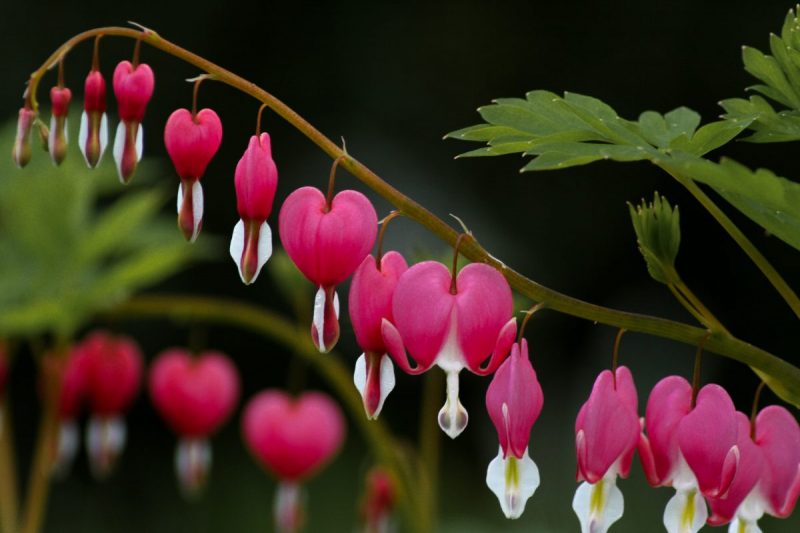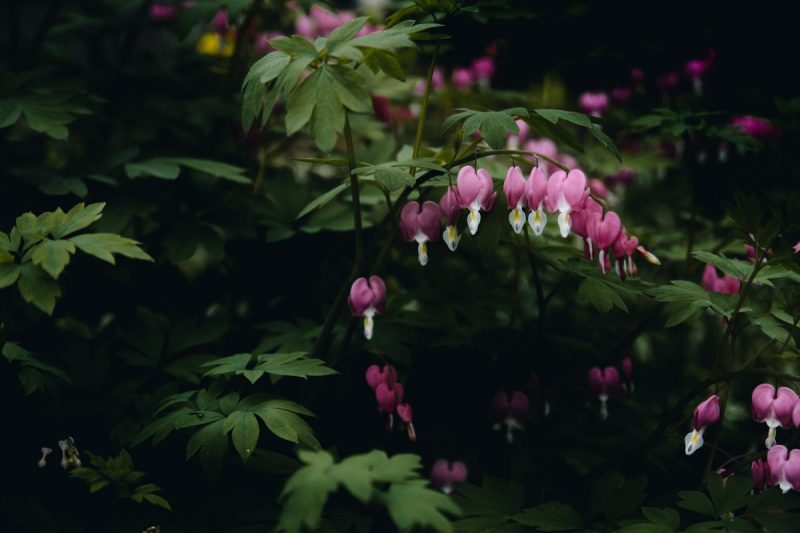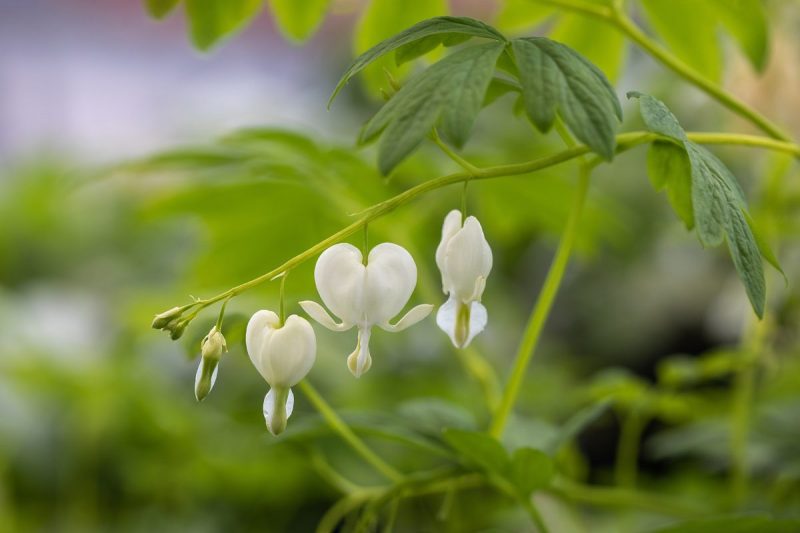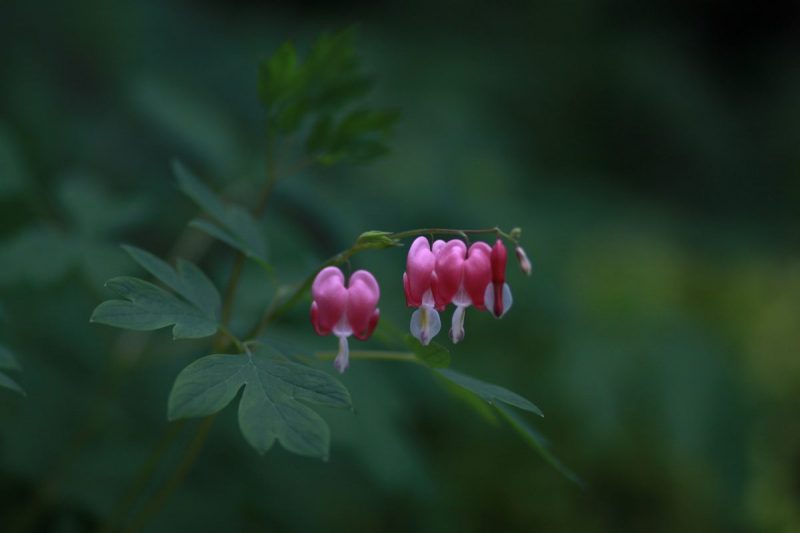Asian bleeding-heart, planting guide and care work

Asian bleeding-heart (Lamprocapnos spectabilis) is a perennial herbaceous plant, originally from East Asia. The plant has a moderate growth, reaching up to 90 cm in height. The pink or white flowers hang on arched stems and look like earrings. The flowers are clustered in racemes, have the shape of a heart, are flattened laterally and have 2 terminal inflorescences. The flowers appear in early spring. The leaves are alternately arranged (located on one side and the other of the stem), divided and pointed at the tip. The stems are branched, reddish and smooth. Asian bleeding-heart is often grown in gardens and parks, planted directly in the soil, but it can also be grown in flowerpots.
Asian bleeding-heart – varieties and cultivars
- Lamprocapnos spectabilis ‘Alba’: variety with white flowers;
- Lamprocapnos spectabilis ‘Gold Heart’: the flowers are pink and the leaves have a golden tint;
- Lamprocapnos spectabilis ‘Valentine’: variety with burgundy stems on which red flowers are attached.



Environmental conditions
Light. It grows and blooms in partial shade. It can also grow in sunny places and it prefers the morning sun.
Temperature. The optimal temperature range is 12-23 ℃. High temperatures can cause the yellowing of the leaves.
Soil. It needs a soil rich in organic matter, well drained, damp, with a slightly acidic or neutral pH.
Asian bleeding-heart – care
Watering. It needs regular watering, so that the soil is maintained damp. It is recommended to avoid excessive moisture as it can lead to root rot.
Fertilizing. Fertilization is optional and can be done depending on the quality of the soil and the content of organic matter. In the case of poor soils, it is recommended to administer a slow-release fertilizer in the spring.
Recommended products
-
You can find products on a different store
Change Store -
You can find products on a different store
Change Store -
You can find products on a different store
Change Store -
You can find products on a different store
Change Store -
You can find products on a different store
Change Store -
You can find products on a different store
Change Store -
You can find products on a different store
Change Store -
You can find products on a different store
Change Store -
You can find products on a different store
Change Store -
You can find products on a different store
Change Store -
You can find products on a different store
Change Store -
You can find products on a different store
Change Store -
You can find products on a different store
Change Store -
You can find products on a different store
Change Store -
You can find products on a different store
Change Store -
You can find products on a different store
Change Store -
You can find products on a different store
Change Store -
You can find products on a different store
Change Store -
You can find products on a different store
Change Store -
You can find products on a different store
Change Store -
You can find products on a different store
Change Store -
You can find products on a different store
Change Store -
You can find products on a different store
Change Store -
You can find products on a different store
Change Store
Propagation. The plants can be propagated by dividing the bush, stem cuttings or seeds. The most common propagation method is by dividing the bush. This can be done in the spring, after the flowering period.
Dormancy. The plants lose their leaves with the arrival of the cold season. Thus, they can be shortened to approximately 2-4 cm above the ground level. At the beginning of the cold season, to protect the roots from frost, a layer of mulch can be added on top of the plant stems. The mulch will be removed in the spring, when the soil begins to thaw.
Diseases and pests
Plants can be affected by diseases such as powdery mildew amd various leaf spots. Among the pests, aphids, European fruit lecanium, snails and slugs can infest the plant.
Recommended products
-
You can find products on a different store
Change Store -
You can find products on a different store
Change Store -
You can find products on a different store
Change Store -
You can find products on a different store
Change Store -
You can find products on a different store
Change Store -
You can find products on a different store
Change Store -
You can find products on a different store
Change Store -
You can find products on a different store
Change Store -
You can find products on a different store
Change Store -
You can find products on a different store
Change Store -
You can find products on a different store
Change Store -
You can find products on a different store
Change Store -
You can find products on a different store
Change Store -
You can find products on a different store
Change Store -
You can find products on a different store
Change Store -
You can find products on a different store
Change Store -
You can find products on a different store
Change Store -
You can find products on a different store
Change Store -
You can find products on a different store
Change Store -
You can find products on a different store
Change Store -
You can find products on a different store
Change Store -
You can find products on a different store
Change Store -
You can find products on a different store
Change Store -
You can find products on a different store
Change Store
Recommended products
-
You can find products on a different store
Change Store -
You can find products on a different store
Change Store -
You can find products on a different store
Change Store -
You can find products on a different store
Change Store -
You can find products on a different store
Change Store -
You can find products on a different store
Change Store -
You can find products on a different store
Change Store -
You can find products on a different store
Change Store -
You can find products on a different store
Change Store -
You can find products on a different store
Change Store -
You can find products on a different store
Change Store -
You can find products on a different store
Change Store -
You can find products on a different store
Change Store -
You can find products on a different store
Change Store -
You can find products on a different store
Change Store -
You can find products on a different store
Change Store -
You can find products on a different store
Change Store -
You can find products on a different store
Change Store -
You can find products on a different store
Change Store -
You can find products on a different store
Change Store -
You can find products on a different store
Change Store -
You can find products on a different store
Change Store -
You can find products on a different store
Change Store -
You can find products on a different store
Change Store
Additionally:
- It is possible that the plants will not bloom in the first growing season;
- To prevent the occurrence of foliar diseases, especially powdery mildew, it is recommended that watering be done at the base of the plants (not on the leaves). It is also important to ensure a good ventilation between the plants;
- The yellowing of the leaves is often caused by improper watering, too alkaline soil, too much direct sunlight or high temperatures;
- Asian bleeding-heart can also grow in apartment conditions if the environmental requirements are respected and it is protected from drafts or too high temperatures.















































































































































































































































































































































































































































